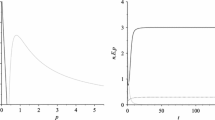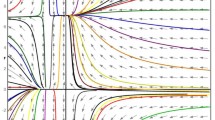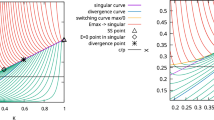Abstract
We present a mathematical model of a fishery on several sites with a variable price. The model takes into account the evolution during the time of the resource, fish and boat movement between the different sites, fishing effort and price that varies with respect to supply and demand. We suppose that the movements of the boats and resource as well as the variation of the price go on at a fast time scale. We use methods of aggregation of variables in order to reduce the number of variables and we derive a reduced model governing two global variables, respectively the biomass of the resource and the fishing effort of the whole fishery. We look for the existence of equilibria of the aggregated model and perform local stability analysis. Two main cases can occur. The first one corresponds to over-exploitation leading to fish extinction. At extinction, the fishing effort tends to a positive value. The second case corresponds to a durable fishery equilibrium which is globally asymptotically stable. In the later case, we show that there exists a number of fishing sites that optimizes the total catch of the fishery.




Similar content being viewed by others
References
Auger P, Mchich R, Raissi N, Kooi B (2010a) Effects of market price on the dynamics of a spatial fishery model: over-exploited fishery/traditional fishery. Ecol Complex 7:13–20
Auger P, Lett C, Moussaoui A, Pioch S (2010b) Optimal number of sites in artificial pelagic multi-site fisheries. Can J Fish Aquat Sci 67:296–303
Auger P, Moussaoui A, Sallet G (2012) Basic reproduction ratio for a fishery model in a patchy environment. Acta Biotheor 60:167–188
Barbier EB, Strand I, Sathirathai S (2002) Do open access conditions affect the valuation of an externality? Estimating the welfare effects of mangrove-fishery linkages. Env Resour Econ 21:343–367
Clark CW (1990) Mathematical. Bioeconomics: the optimal management of renewable resources, 2nd edn. Wiley, New York
de Lara M, Doyen L (2008) Sustainable management of renewable resources: mathematical models and methods. Springer, Berlin
Dagorn L, Holland KN, Itano DG (2007) Behavior of yellowfin (Thunnus albacares) and bigeye (T. obesus) tuna in a network of fish aggregating devices (FADs). Mar Biol 151(2):595–606
Fonteneau A, Ariz J, Gaertner D, Nordstrom T, Pallares P (2000) Observed changes in the species composition of tuna schools in the Gulf of Guinea between 1981 and 1999, in relation with the fish aggregrating device fishery. Aquat Living Resour 13(4):253–257
Girard C, Benhamou S, Dagorn L (2004) FAD: fish aggregating device or fish attracting device? A new analysis of yellowfin tuna movements around floating objects. Anim Behav 67(2):319–326
Moreno G, Dagorn L, Sancho G, Itano D (2007) Fish behaviour from fisher’s knowledge: the case study of tropical tuna around drifting fish aggregating devices (DFADs). Can J Fish Aquat Sci 64(11):1517–1528
Moussaoui A, Auger P, Lett C (2011) Optimal number of sites in multi-site fisheries with fish stock dependent migrations. Math Biosci Eng 8:769–783
Ohta I, Kakuma S (2005) Periodic behavior and residence time of yellowfin and bigeye tuna associated with fish aggregating devices around Okinawa Islands, as identified with automated listening stations. Mar Biol 146(3):581–594
Schaefer MB (1957) Some considerations of population dynamics and economics in relation to the management of the commercial marine fisheries. J Fish Res Board Canada 14:669
Smith VL (1968) Economics of production from natural resources. Am Econ Rev 58(3):409–431
Smith VL (1969) On models of commercial fishing. J Political Econ 77(2):181–198
Thiao D, Chaboud C, Samba A, Lalo F, Cury P (2012) Economic dimension of the collapse of the ‘false cod’. Epinephelus aeneus in a context of ineffective management of the small-scale fisheries in Senegal. Afr J Mar Sci 34(3):305–311
Author information
Authors and Affiliations
Corresponding author
Appendices
Appendix 1: Calculation of the Fast Equilibria
We notice that \(n(t)\) and \(E(t)\), the global variables, are constants of motion of the fast process: migration and price variation. Fast equilibria are the solutions of the following system:
Since \(m_{is}=\frac{m_{0}}{k_{s}}\) and \(m_{si}=\frac{m_{0}}{k_{i}}\) substituting \(m_{is}\) and \(m_{si}\) into the Eq. (16) leads to
Since \(n=\displaystyle \sum _{i=1}^{\text {L}}n_{i}^{*}+n_{s}^{*}\) \(\Rightarrow\) \(n=\displaystyle \sum\nolimits _{i=1}^{\text {L}}\frac{k_i}{k_s}n_{s}^{*}+n_{s}^{*}\) \(\Rightarrow\) \(n=n_{s}^{*}\frac{\sum\nolimits _{i=1}^{\text {L}}k_{i}+k_{s}}{k_s}\) leads to:
Equation (17) states that \(\beta _{1,2}E_{2}=\beta _{2,1}E_{1}\). As symmetric movement rates for boats were assumed, \(\beta _{1,2}=\beta _{2,1}\) and therefore, \(E_1 = E_2\) at equilibrium. Then a simple recurrence shows that \(\forall i, E_i=E_{i+1}\). As a consequence, we obtain \(\forall i \in \{1,\ldots ,\text {L}\}\) \(E_{i}^{*}=E_{1}^{*}\). So, with \(E=\displaystyle \sum _{i=1}^{\text {L}}E_{i}^{*}\) we obtain the following result
From Eq. (18), we deduce that
where \(Q = q(1-\alpha )/\text {L}\). Because \(D(p) = \frac{A}{p}\), at fast equilibrium, we have
Appendix 2: Derivation of the Aggregated Model
We substitute the fast equilibria computed in previous section and we obtain the following system:
Since \(n=\sum _{i=1}^{\text {L}}n_{i}+ n_{s}\) we have \(\frac{dn}{d\tau }=\sum _{i=1}^{\text {L}}\frac{dn_i}{d\tau }+\frac{dn_s}{d\tau }\). We perform a change of timescale \(t=\varepsilon \tau\). At slow time scale, the equation governing total fish stock reads:
We denote \(r= \alpha r_{s}+ (1-\alpha )r_{1}\) and \(Q=\frac{q(1-\alpha )}{\text {L}}\). At slow time scale, the equation for fish stock finally reads:
Equation governing total fishing efforts \(E\) at slow time scale reads
At slow scale time we finally have
where \(p^*\) depends on \(n\) and \(E\) and is given by Eq. (23).
Rights and permissions
About this article
Cite this article
Ly, S., Auger, P. & Balde, M. A Bioeconomic Model of a Multi-site Fishery with Nonlinear Demand Function: Number of Sites Optimizing the Total Catch. Acta Biotheor 62, 371–384 (2014). https://doi.org/10.1007/s10441-014-9222-z
Received:
Accepted:
Published:
Issue Date:
DOI: https://doi.org/10.1007/s10441-014-9222-z




